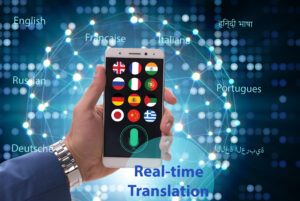When it comes to modern investigations, a single testimony can alter an entire case—but what happens when it’s in a language you cannot understand?
Although borderless crime has been a prevalent issue for some time, the digitally connected world we live in makes this even more challenging for law enforcement and justice to protect. With the advent of generative AI, we’re seeing levels of cybercrime, fraud, and other criminal activities grow to levels we’ve not seen before. Cybersecurity Ventures expects global cybercrime costs to increase by 15 percent annually, costing USD 10.5 trillion in 2025.
To add to the growing problem of borderless crimes, the challenge of language barriers can significantly slow investigations, ultimately impacting the outcome of cases and trials. It is vital to collect evidence, but if it requires statements from someone who speaks another language, it can take time and resources away from the investigation to translate.
This is where real-time translation comes in. It is a powerful tool that provides live captions of speakers conversing in one language while translating the text into another for other interview participants.
In this article, we will explore the innovative technology of real-time translation, how it can support cross-border investigations, and how it compares to human interpreters.
The New Reality of Borderless Crime
Borderless crime covers various crimes, including organized crime, cyberattacks, and terrorism. Organized Crime Groups (OCGs) commit a range of serious offences from drug smuggling to human trafficking. These groups can easily span countries and even continents, making it extremely difficult for law enforcement to track and prosecute members of OCGs. A language barrier could exist when law enforcement charges OCG criminals or takes statements from victims and witnesses.
As discussed earlier, language barriers further complicate investigations, as evidence can be multilingual. This would require interpreters to translate interviews, messages, and documents, which can hinder the progress of investigations.
Real-Time Translation vs. Human Interpreters
So, can real-time translation be used instead of human interpreters when taking statements in an interview scenario?
Speed and Efficiency
Real-time translation technology provides near-instant output, vitally important during time-sensitive and urgent interviews. On the other hand, human interpreters require scheduling for the interview, and are limited based on availability. Another neglected factor is the forgetting curve that interviewees experience, primarily if they cannot communicate their statement shortly after the crime. The later a statement is taken, the more likely the interviewee is to forget details of the incident.
Scalability
Real-time translation can process large volumes of data, and some variants can process multiple languages simultaneously, meaning that interviews can be conducted in several languages. Interpreters of a multilingual video interview would struggle, mainly if more than two languages are being spoken, requiring potentially more than one interpreter.
Quality and Context
One often overlooked aspect of translation is the quality of the interpreter’s response to the interviewer and how the presence of an interpreter alters the interview context. If you’ve ever spoken with someone through an interpreter, you may have noticed the impact of having a third person relay the conversation and how it affects its flow.
More importantly, what if the interpreter misses critical details or does not communicate them back to the interviewer? Real-time translation eliminates these disruptions, maintaining the natural flow of interviews and ensuring that responses remain accurate, even in multilingual conversations.
Accuracy
Whilst real-time translation is a powerful technology, the accuracy of translated conversations is yet to be 100%. Advances in AI will continue to improve the percentage accuracy of this tech. A human interpreter may need to oversee the translation in specific scenarios, especially in nuanced or highly sensitive interviews.
Operational Benefits of Real-Time Translation in Investigations
Due to the overwhelming amount of evidence required in cases, including witness, victim, and suspect statements, real-time translation offers many operational benefits.
Accelerating Evidence Analysis
By removing language barriers using real-time translation, the process of gathering and analysing evidence is reduced. Cross-border cooperation has increased, leading to faster case resolutions.
Supporting Multilingual Interviews
Real-time translation allows for interviews between participants who speak different languages with near-instant live captions. This enables positive and efficient conversations with victims and witnesses without relying on and waiting for interpreters.
Evidential Integrity
Secure video interview platforms, such as MeaConnexus, maintain evidential integrity from the outset of the recording. This means you will know if the contents of the interview recordings have been changed or altered. Therefore, you will be informed if translated material, including the interview recording and transcript, has been modified.
Cost Savings
The cost of real-time translation pales compared to booking an interpreter for the interview. The cost of hiring an interpreter may include travel, accommodation, and subsistence expenses like food or parking charges.
Is Your Organization Ready for Borderless Investigations?
Now more than ever, we must ensure language barriers aren’t barriers and can be overcome quickly and efficiently. Instead of impeding investigations and evidence collection, real-time translation offers a next-gen solution for interviewers, supporting multilingual interviews.
If you currently have to contend with multilingual evidence and testimony, how quickly can your team translate and analyse the evidence? If you don’t, are you equipped to handle the demands of cross-border crime in real time?
We’d like to leave you with one last question: Could real-time translation improve the speed and accuracy of your investigations?


